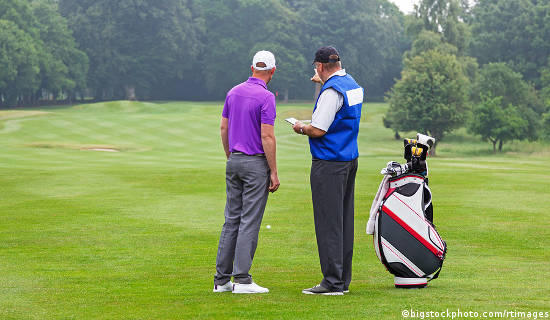A funny thing happened while reliving the highlights of Justin Thomas’s first (and, perhaps, overdue) victory on the PGA Tour this past week in Malaysia.
It wasn’t a40-footer for birdie, a hole-out bunker shot, or even a nervy five-footer to finish it off. It was the fist pump. Not from Thomas. But from Jimmy Johnson.
A completely under-reported development in Thomas’ career was his switch in looper this summer. Johnson, a 20-year caddying veteran who had been shopping for a permanent home during the gradual competitive retirement of Steve Stricker, had been linked to a number of young stars over the past couple of years. The courtship with Thomas began with a partnership at The Greenbrier and was formalized in time for the PGA Championship. Since then? Five top-20s in seven starts, a win and a FedEx Cup lead.
“I'm very fortunate to have him,” Thomas said after his win. “He had been in a lot of situations and a lot of scenarios very similar to today. I mean, a situation like today was pretty normal or common [for him]. Obviously, I'm sure he's still feeling it like a little bit less than I was, I would say, but he had been there a lot. And that was huge for me today.”
Thomas deserves a ton of credit for working his way to a position to win, but do we diminish the value added by a veteran on the bag? Is there a way to quantify what Johnson brought to the Thomas "team"? Perhaps who is carrying the bag is even more important than what’s in it.
On the same weekend Johnson got back in the winner’s circle with his fourth full-time PGA Tour client (Stricker, Nick Price and Charles Howell III), arguably the best caddie of this generation was slinging darts at his former client. While Steve Williams may remember his time on Tiger Woods’ bag as a decade-plus of indentured servitude, his value has been more enhanced in retirement than on the course.
Adam Scott was always a world-class player, rising as high as No. 4 in the world in 2006. Prior to Williams, Scott won 18 times worldwide. Hard to call that a failure. But, in the summer of 2011, the Aussie had fallen outside of the top 20. By the Open Championship that year, with Williams earning his freedom from Woods, a new partnership was born.
We know that Williams helped Scott win again, and soon. He helped get him to that first major, rise to No. 1 and put together the best 12-month season in 2013. But, that doesn’t tell the whole story. In the 11 seasons before Williams was on the bag, Scott averaged 4.58 missed cuts per season. In the three-and-a-half years the two combined forces, Scott missed one cut, the 2012 Byron Nelson, during that entire span. ONE!
Away from the results, the confidence and edge that Williams provided Scott was noticeable to anybody who covered the gentle man from down under. That edge had been missing in 2015, and warranted a call to bring Williams out of retirement for the majors.
“I thought I'd take a shot and give him a call even though he was adamant he wasn't coming out [of retirement],” Scott said this summer at Saint Andrews. “I then had to go practice really hard so I was going to play as good as he'd expect.”
Think about that last line for a second. It was somewhat tongue-in-cheek, but there was reality to it as well. Williams brought out the best in Scott, and he knew it. In their three full seasons together, Scott’s scoring average was 69.35. This past season? 70.46. Is it really that simple? Probably not, but if we developed a strokes-gained caddying stat, Williams was +1.1. Not too shabby.
Those two examples may be skewed a bit because you are combining two prodigious talents with two tremendous managers of players. When proven commodities combine forces, the stock goes up. But, if you look at the top five players in the world right now, almost every player-caddie relationship makes sense based on player need:
Jason Day has Col Swatton, a father-like figure who doubles as a best friend and knows every inch of Day’s golf swing and competitive ticks.
Jordan Spieth has matured as quickly as a player as Michael Greller has as a bag man. They have evolved together to create a system of success, on display beautifully at Chambers Bay this summer, as Greller used key phrases and expressions to keep Spieth grounded and in the moment.
“That was probably the best work Michael has ever done this week to get me through,” Spieth recounted afterwards.
Rory McIlroy and J.P. Fitzgerald were rumored to be on the rocks during the “slide” in 2013, but nobody manages the golf needs of the former No. 1 better.
Bubba has a saint in Ted Scott, leave it at that.
Rickie Fowler has childhood friend Joe Skovron on his bag, creating comfort both on and off the course.
So, to summarize, you have a protector, a partner, a manager, a counselor and a friend, if you were to describe each. Five men tasked with doing the same job, but who go about it in different ways based on the desired relationship of the player.
None of those relationships have come about haphazardly. They are as calculated as shaft setup or Sunday’s wardrobe.
With the young stars of the game taking golf by storm this fall, pay attention to the choices made on who gets some of the marquee loops on Tour. If you think some peers weren’t paying attention to Thomas’ move to Johnson, think again. I’d bet Joe LeCava’s phone is ringing right now. Tiger isn’t paying like the kids these days are!

